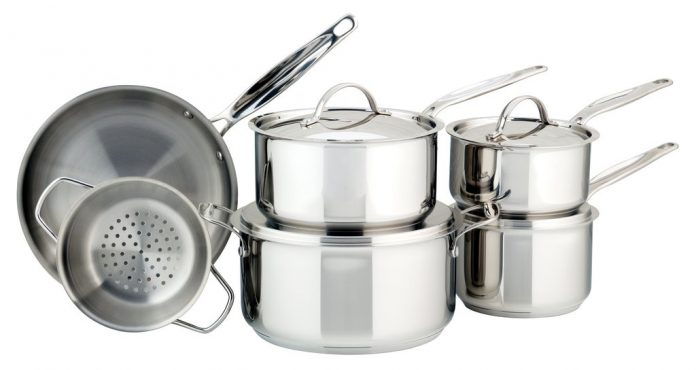Anodizing aluminum is a process of passing an electrical current through an electrolyte solution (sulfuric acid) between two poles, an anode, and a cathode. The procedure results in a fine, highly durable, and attractive metal surface. Anodized aluminum has many uses, including aircraft components, sports gear, and precision machine parts. Anodizing aluminum can also result in components that can be used in cookware. But how safe is cookware made from anodized aluminum?
What are the attractions of anodized aluminum cookware?
Cookware made of anodized aluminum is non-stick, not susceptible to scratches, and extremely easy to clean. The way it works is that the aluminum metal is coated with an oxide layer, which keeps the metal from leaching into food. The usual cases of metal pots and pans reacting with acidic foods like tomatoes are non-existent when it comes to aluminum cookware.
Concerns about anodized aluminum
As one of the most abundant metals, aluminum is found in plenty in the earth’s crust. It is also located in soil, water, and plants. Aluminum is also usually present in our water supplies and food sources. Scientific evidence shows that taking aluminum into the body harms the kidneys and makes bones weaker.
This happens when aluminum depletes the body’s repository of phosphorus and calcium. The fact that aluminum is not required by the human body and is highly reactive chemically means it is not very healthy for humans to consume. Some studies attempted to make a connection between aluminum and Alzheimer’s disease, but have since been shown to be false.
Cooking using aluminum cookware
The cookware found in many kitchens is made from anodized aluminum and has stainless steel surfaces. Aluminum has exceptional ability to conduct heat and is therefore used on the exterior surface. If the cookware doesn’t have scratches on it, it is okay. However, if scratched anodized aluminum pots and pans come into contact with acidic liquids or foods, the liquids will react with the metal and eventually get into the food. The people who are most at risk of aluminum poisoning are those who take aluminum-based antacids more than once a day or multiple times a week. Most of us do not ingest more than 50mg of aluminum daily.
Anodized Aluminum products are safe
Many cookware products made from anodized aluminum possess a superior gleaming finish that is also attractive. It has been shown that anodizing aluminum is both safe and environmentally friendly. This is because anodizing aluminum only accelerates a process that occurs in nature that does not generate any harmful by-products.
Benefits of anodized cookware
- The glossy, attractive finish does not decompose or break down over time
- The anodized aluminum surface is non-toxic
- The covers are heat resistant, up to a temperature of 1221 degrees Fahrenheit
- The procedure of anodizing makes use of water-based chemicals that are easily treated and generate harmful by-products
- By-products of the process that are liquid are recycled
- The solid by-products are separated and used in aluminum manufacture, fertilizer, cosmetics, baking powder, and newsprint.
- The primarily primary by-products of anodizing aluminum are harmless. E.g., aluminum sulfate and aluminum hydroxide, which can be put to use in sewage treatment plants.
Conclusion
Cookware made from anodizing aluminum is entirely safe to use. Moreover, anodized aluminum cookware has many benefits, including a smooth finish, heat resistance, and non-toxicity.











